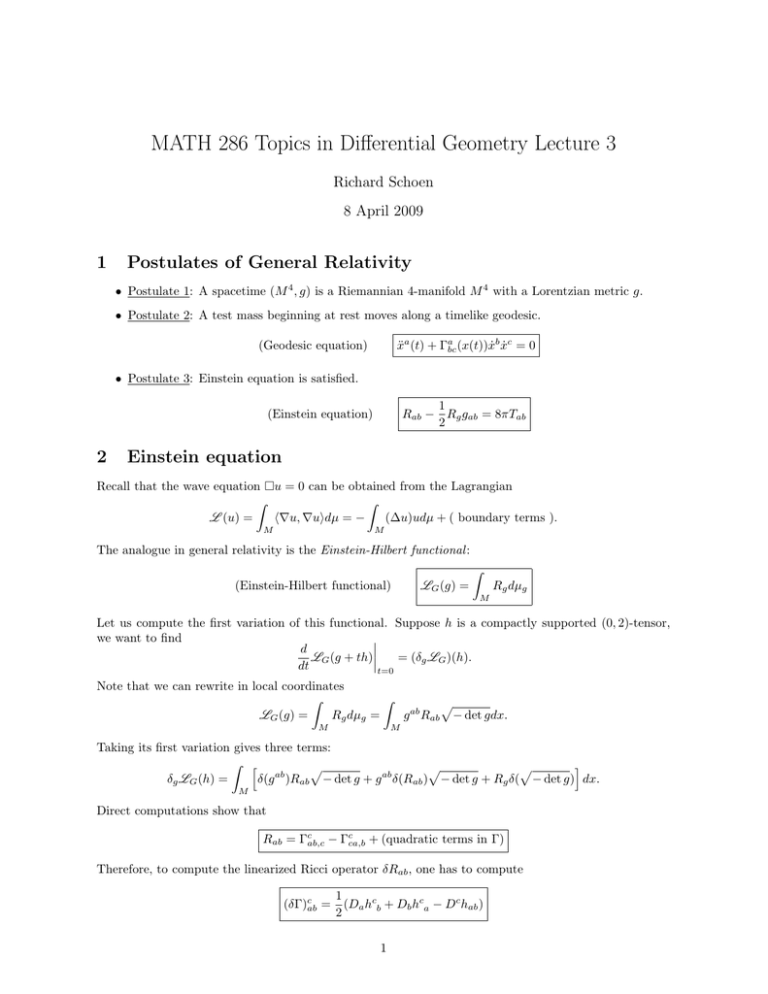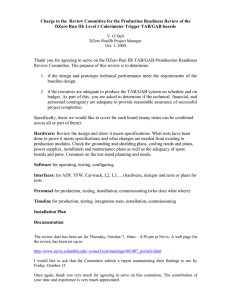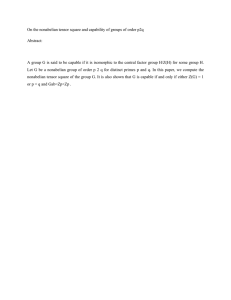General Relativity & Differential Geometry Lecture Notes
advertisement

MATH 286 Topics in Differential Geometry Lecture 3 Richard Schoen 8 April 2009 1 Postulates of General Relativity • Postulate 1: A spacetime (M 4 , g) is a Riemannian 4-manifold M 4 with a Lorentzian metric g. • Postulate 2: A test mass beginning at rest moves along a timelike geodesic. ẍa (t) + Γabc (x(t))ẋb ẋc = 0 (Geodesic equation) • Postulate 3: Einstein equation is satisfied. 1 Rab − Rg gab = 8πTab 2 (Einstein equation) 2 Einstein equation Recall that the wave equation u = 0 can be obtained from the Lagrangian Z Z L (u) = h∇u, ∇uidµ = − (∆u)udµ + ( boundary terms ). M M The analogue in general relativity is the Einstein-Hilbert functional : (Einstein-Hilbert functional) LG (g) = Z Rg dµg M Let us compute the first variation of this functional. Suppose h is a compactly supported (0, 2)-tensor, we want to find d LG (g + th) = (δg LG )(h). dt t=0 Note that we can rewrite in local coordinates Z Z LG (g) = Rg dµg = M g ab Rab p − det gdx. M Taking its first variation gives three terms: Z h i p p p δg LG (h) = δ(g ab )Rab − det g + g ab δ(Rab ) − det g + Rg δ( − det g) dx. M Direct computations show that Rab = Γcab,c − Γcca,b + (quadratic terms in Γ) Therefore, to compute the linearized Ricci operator δRab , one has to compute (δΓ)cab = 1 (Da hcb + Db hca − Dc hab ) 2 1 Note that while Γcab is not a tensor, (δΓ)cab is a tensor. In particular, one can pick geodesic normal coordinates to make Γcab = 0 at a point. Therefore, we get δRab = Dc (δΓ)cab − Db (δΓ)cca , using the above expression for (δΓ)cab , we have the linearized Ricci operator 1 1 δRab = − Dc Dc hab + Dc (Da hbc + Db hac ) − Da Db (Tr h) 2 2 where Tr h = g ab hab is the trace of h. The key observation here is that all the terms are divergence terms, hence integrate to zero as h is compactly supported. Therefore, the middle term has been taken care of, the other two terms are relatively easier to handle. They only involve variations of the metric g. Standard calculations give δg ab = −hab 1 X ab 1 1 δ(− det g) = g hab = Tr h δ log(− det g)1/2 = 2 − det g 2 2 where hab = g ap g bq hpq . Combining all these, we have Z 1 δg LG (h) = − (Rab − Rg gab )hab dµ. 2 M Defining the Einstein tensor Gab to be (Einstein tensor) 1 Gab = Rab − Rg gab 2 Since hab is arbitrary, any critical point of the functional LG satisifies the vacuum Einstein equation: (VEE’) 1 Gab = Rab − Rg gab = 0 2 Taking trace on both sides, one sees that Rg = 0, hence we can rewrite the equation as Rab = 0 (V EE) In other words, the metric g is Ricci flat. In general, when a matter field is present, we have the general Einstein equation: (EE) 1 Rab − Rg gab = 8πTab 2 where Tab is the stress-energy tensor of the matter field. Just like before, we can take trace on both sides to get −Rg = 8πT , where T = g ab Tab is the trace of Tab . Hence, we can rewrite (EE) in the following form 1 (EE’) Rab = 8π(Tab − T gab ) 2 3 Local Conservation of Energy The diffeomorphism invariance of the Einstein equation is related to the conservation of energy. Let X be a compactly supported vector field on M , and let Ft be the 1-parameter family of diffeomorphisms generated by X. Note that the Einstein-Hilbert functional is diffeomorphism invariant, because scalar curvature is a diffeomorphism invariant (i.e. RFt∗ g = Ft∗ Rg ), LG (Ft∗ g) ≡ LG (g). 2 Differentiate in t at t = 0, one obtains δLG (LX (g)) = 0. Recall that the Lie derivative of the metric g is given by (LX g)ab = Xa,b + Xb,a , using this compactly supported (0, 2)-tensor as our hab in the first variation formula for LG , Z Z Gab (Xa,b + Xb,a ) = 2 Gab Xa,b = 0, M M where we have made use of the fact that the Einstein tensor Gab is symmetric. Integrating by part, one has Z Db Gab X a = 0 M for any compactly supported vector field X. Hence, we see that the Einstein tensor Gab is divergence free: Db Gab = 0 Remark 1. One can also derive the above divergence-free property from the definition of Gab and the Bianchi identities for the Riemann curvature tensor. The approach we gave here is more variational. In conclusion, using just the Einstein equation, we automatically recover the local conservation of energy Db Tab = 0 4 Dominant energy condition In order to have a sensible physical theory, we need to impose some energy conditions on the stress-energy tensor Tab . Let e0 , e1 , e2 , e3 be a Lorentz frame, where e0 is timelike, and e1 , e2 , e3 are spacelike. The component T00 is the observed mass density, with the observer moving in the e0 -direction. One natural assumption is that mass density should be non-negative: T00 ≥ 0. In fact, we usually impose the stronger positivity condition (DEC) T00 ≥ 3 X ! 21 2 T0i i=1 This is called the dominant energy condition. We can state it in a coordinate free manner (DEC’) For all unit timelike vector v, T (v, v) ≥ max w∈v ⊥ ,kwk=1 T (v, w). Loosely speaking, this condition is saying that the Ricci tensor is non-negative in timelike directions. 5 Canonical stress-energy tensor Now, we turn to the issue on how one can come up with a stress-energy tensor Tab . Let ψ be a matter field, which is invariantly defined on a curved spacetime (M 4 , g). Suppose we have some Lagrangian functional L (ψ, g) which depends on both the matter field ψ and the Lorentz metric g. If we look at the first variation of L in the ψ-variable, we get the equations of motions for ψ: δψ Lψ = 0 (EOM) 3 Now, consider a compactly supported vector field X, which generates a family of diffeomorphisms Ft . Assuming the Lagrangian L is diffeomorphism invariant, then L (Ft∗ ψ, Ft∗ g) ≡ L (ψ, g). Taking derivative in t at t = 0, we get from chain rule δψ L (ψ̇) + δg L (LX g) = 0. If we assume that ψ satisfies the equation of motions (EOM) w.r.t. g, then the above equation reduces to δg L (LX g) = 0. Definition 1. We define the stress-energy tensor Tab to be δg L (h) = − Z hT, hig dµg M for all compactly supported (0, 2)-tensor h. Similar to what we did earlier, for any compactly supported vector field X, Z 0 = δg L (LX g) = − T ab (Xa;b + Xb;a )dµg M Z = −2 T ab Xa;b dµg Z M = 2 T ab;b Xa dµg M Therefore, we obtained again the conservation law T ab;b = 0 Example 1. 1. Scalar Field: Consider the following Lagrangian LKG (u, g) = Z h∇u, ∇ui + m2 u2 dµg M where u ∈ C ∞ (M ) and m ≥ 0 is some fixed constant. The corresponding equations of motion for u is (Klein-Gordon equation) −g ab Dab u + m2 u = 0 Let us compute the stress-energy tensor Tab for LKG . Suppose (δg)ab = hab , then Z 1 ab 2 2 2 δg LKG (h) = − h ∂a u∂b u − (k∇ukg + m u )gab dx. 2 M Therefore, in this case, 1 Tab = ∂a u∂b u − (k∇uk2g + m2 u2 )gab 2 From the general discussion above, such a Tab must be divergence-free. Moreover, Tab satisfies the 4 (DEC). Let’s check this: 1 (∂0 u)2 + (k∇uk2g + m2 u2 ) 2 = ∂0 u∂i u 3 X 2 = (∂0 u) (∂i u)2 T00 = T0i 3 X 2 T0i i=1 i=1 3 1 X ≤ (∂0 u)4 + ( (∂i u)2 )2 4 i=1 1 (∂0 u)4 + k∇uk4g 4 2 T00 ≤ ≤ Altogether, we have a coupled system Rab − 12 Rg gab = 8πTab −g Da Db u + m2 u = 0 ab One should keep in mind that Tab does not act as a source term here. It is actually part of the unknowns that we have to solve in the coupled system. The unknowns in this system is the metric gab and the function u (which in turn gives Tab ). 2. Electromagnetism: Consider the following Lagrangian LEM (F, g) = 1 8π Z g ap g bq Fab Fpq p − det gdx M where F ∈ Ω2 (M ) is a 2-form on M . The equations of motion for F is exactly the Maxwell equations dF = 0 δF = 0 and the stress-energy tensor is Tab 1 = 4π 1 g Fap Fbq − hF, F ig gab 4 pq Note that we no longer have global conservation laws because the general spacetime (M 4 , g) has no global Killing vector fields. However, one can still get local approximate conservation laws by looking at a small enough region (where one can obtain approximate local isometries). 3. Perfect Fluid: Unlike the above two examples, in this case, we do not have a Lagrangian for perfect fluid. We have to define our stress-energy tensor Tab from scratch. Let u be a velocity 4-vector field which is normalized such that hu, ui = −1, then one defines Tab = ρua ub + P (gab + ua ub ) where ρ, P are smooth functions on the whole spacetime which represents the mass density and the fluid pressure respectively. For an observer which is at rest with respect to the fluid path, one gets ρ 0 0 0 0 P 0 0 (Tab ) = 0 0 P 0 . 0 0 0 P 5

